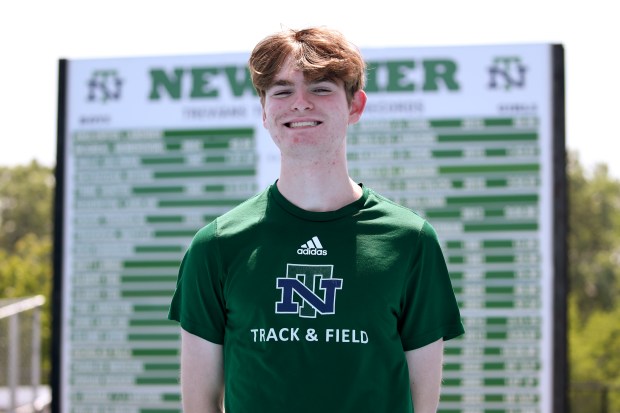The sun has a starring role in the solar system, but it will be eclipsed briefly by the moon on April 8.
The rare event, when the moon blocks out the sun, has Hoosiers and others scrambling for a chance to witness the cosmic spectacle.
“So many people get excited over this, as they should, because it’s a really exciting spectacle,” said Jessica Warren, an astrophysicist at Indiana University Northwest.
Warren put it in perspective during her weekend lecture at Gary Public Library.
“Over 32 million people live in the path of totality for this eclipse,” she said. “This has the potential to be the most-viewed eclipse, certainly in the United States if not in the world.”
“Over 10 major metro areas live within a couple hours’ drive of that totality.”
Eclipse tourism is a big phenomenon, prompting warnings about traffic nightmares and logistics challenges in the path of totality.
In Gary, the eclipse will be significant, with about 95% coverage of the sun.
Viewing safety
For people in the path of the total eclipse, which runs through central and southern Indiana, the only safe time to view it with the naked eye will be the four minutes when it’s at its peak. The rest of the time, special viewing equipment – homemade or purchased for the event – will be required.
Staring at the sun is, of course, harmful to the human eye.
“If you want to walk around like Ray Charles, it’s not my fault,” said Pamela May, head of technology at Gary Public Library, as she led a workshop for participants to build their own eclipse viewers.
May’s students used cereal and cracker boxes, foil, white paper and scissors to build a viewer that lets users see the eclipse safely, by looking at its reflection.
“Although the eclipse can be an exciting thing, it can also be dangerous,” she said. “The sun is going to blind you when you look directly at it.”
On Aug. 21, 2017, May celebrated her birthday in the library’s parking lot with an eclipse viewing.
She learned how to make her cereal box viewer the way many people learn to solve problems – by watching a YouTube video.

Participants in her workshop at the library’s maker space admitted it was more difficult than they thought. Kaylee Glover, 7, and brother Kion Glover Jr., 9, were excited to build their viewers but felt like Aubrien Riggins-Crosby, who initially admitted, “I don’t know what I’m doing.” He successfully finished the project.
“I remember doing this many moons ago,” May said.
How it works
Warren used two paper plates with the centers cut out to explain how solar eclipses work. One represented the Earth’s orbit around the sun and the other the moon’s orbit around the Earth. Where the plates intersect were the equinoxes, the start of spring and autumn.
“If the moon and the sun happen to be on the spot where the Earth and moon’s orbit line up, then we have an eclipse,” Warren said.
That happens every year. What makes eclipses seem so rare, however, is that much of the Earth’s surface is largely uninhabited. Remember the oceans and deserts, she said. “That is why viewing a solar eclipse is somewhat rare.”
The last time northern Indiana saw a total solar eclipse was in 1806, Warren said. For a portion of southeast Indiana, it last happened in 831 AD.
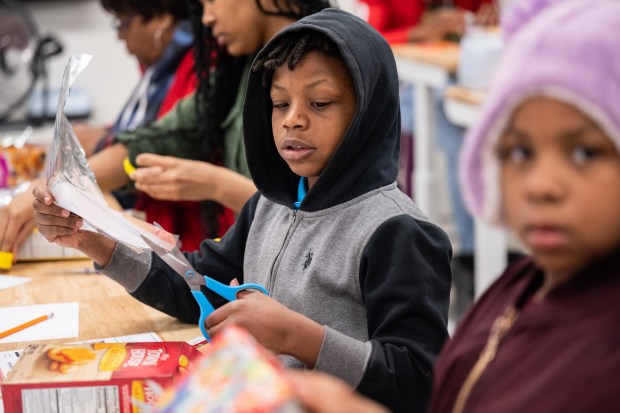
For Northwest Indiana, the next significant partial eclipse will be in 2045. But if you’re waiting for the next total solar eclipse here, you’re waiting for Sept. 14, 2099.
Warren put the size of the Earth, sun and moon in perspective. She held a yardstick with the Earth, about the size of a ping pong ball, and the moon, one-fourth its size, about 30 inches away,
So how big do you think the sun would be on this scale? No one in the lecture hall came close. On that scale, the sun would be 9 feet wide and about 1,000 yards away.
That distance is how the relatively tiny moon can block out the sun, Warren explained. “The sun is about 400 times the size of the moon, but it’s about 400 times farther away.”
Viewing an eclipse brings people closer, she said. “People get together to have this shared experience to view the eclipse.”
“The sun and the moon, it’s right in your face,” she said.
“When you see an eclipse, you are reminded of our direct connection to the universe,” Warren said.
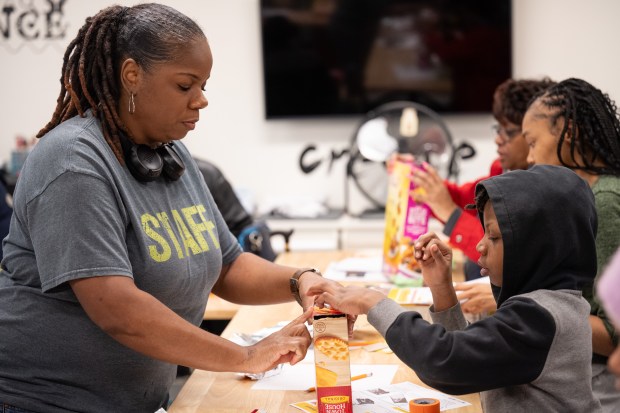
Like May, Warren warned eclipse viewers to wear protection. “You can seriously damage your eyes if you’re not properly protected,” Warren said.
Eclipse viewing glasses purchased on the cheap might not be strong enough, she warned. Look for a label to see if they are ISO 12312-2 certified. “If you put these on and you can see something through it, throw it away,” she said. Wearing the proper glasses, you should be able to see only the sun.
If you wear eyeglasses normally, there’s a filter you can look through to view the eclipse safely. Putting the cardboard glasses on along with your regular glasses might be difficult, Warren said.
Make sure you’re not walking while wearing eclipse glasses; you might trip over a curb or something you can’t see.
Welders can use their masks as long as they’re shade 13 or 14, Warren said.
Timing varies by location
Here, the eclipse will begin at 12:51:27 p.m. April 8 as the moon’s shadow begins to cover the sun. At 2:07:52 p.m., the eclipse will be at its peak. It ends at 3:22:21 p.m.
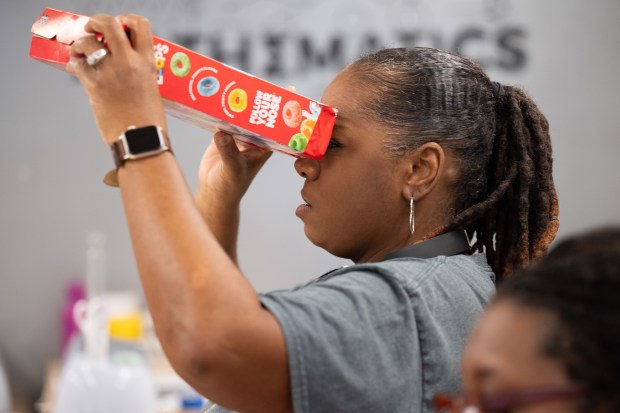
If you’re heading south to view the eclipse, remember much of Indiana is on Eastern time and even then the actual times of the eclipse will change based on where you are, the same as sunset and sunrise happen at different times at different places.
As the eclipse progresses, you’ll notice the lighting will start to dim. “You’ll start to see that the lighting is eerie, just like a cloudy day except there’s a blue sky,” Warren said.
“Animals will start to behave as though it’s twilight,” with birds beginning to roost as if it’s bedtime and crickets getting louder.
NASA and other researchers plan to study animal behavior during the eclipse to learn more, she said.
“You might start to notice that the temperature begins to feel cooler,” Warren said.
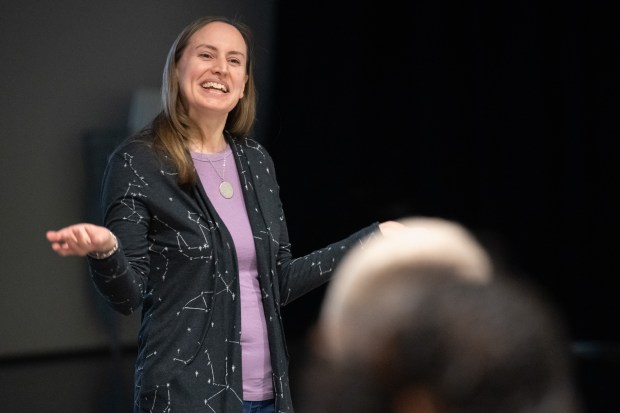
At its peak is when you want to make sure you’re outside to witness the experience. “You might see some bright stars right in the middle of the day.”
Venus will be near the sun but won’t be visible with eclipse glasses on. Look southwest of the sun, blocking the sun from your view, and you might be able to see it.
It’s too early to know what the weather will be like on April 8, but even if it’s a cloudy day you should notice it’s getting darker, Warren said. You’ll be able to find video of the eclipse streaming online, too.
Travel safely
Warren plans to travel with her family to southern Indiana to view the eclipse. “Traffic will be like nothing you’ve ever experienced,” she said. “Fill up on gas, fill up on water.”
“Make sure you get there early,” Warren said. “Pay attention to bathroom access, food access, stuff like that.”
Indiana State Police and the Indiana Department of Transportation echoed her traffic concerns.
“Nearly 4 million Hoosiers live within the path of totality, with hundreds of thousands of people expected to visit Indiana for the event,” a state police news release said. “Increased traffic and congestion are also expected as residents and tourists alike make their way to viewing destinations.”
During the eclipse, get off the road to view it. Don’t stop on the roadway or shoulder to see the phenomenon. Don’t take photos or videos while driving, either. Turn on your headlights manually rather than relying on automatic headlights. Watch for pedestrians, especially along secondary roads. And, of course, don’t wear eclipse glasses while driving, they warned.
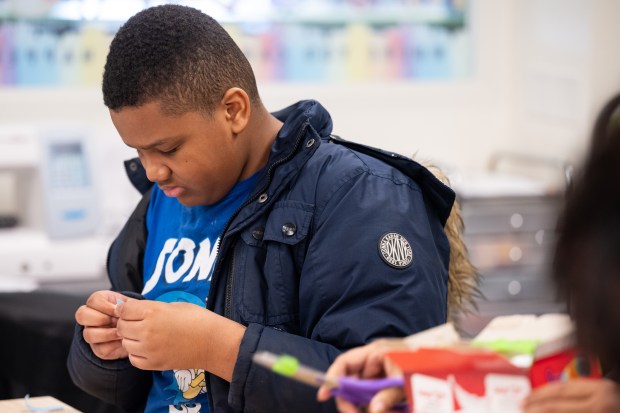
Use INDOT’s TrafficWise mobile app or visit 511in.org to plan your route and monitor traffic conditions both to and from your viewing destination.
The Indiana Board of Animal Health issued its own advisory, warning drivers hauling livestock of “significant traffic delays” associated with eclipse viewing. Heavy trucks don’t belong on neighborhood streets or other roads not meant for heavy vehicles and heavy traffic.
Schools take a break
Ivy Tech Community College is going virtual during the eclipse to keep students off the roads.
Portage Township Schools is sending students home early so buses aren’t running during the eclipse.
Based on feedback from administrators, Superintendent Amanda Alaniz and Associate Superintendent Michael Stephens changed their time frames for dismissal so older siblings are home along with elementary students during the eclipse.
“We’re going to bring all of our students in for a morning half day. They will all receive breakfast and lunch. They will have a modified schedule, and then they will go home and have asynchronous learning more than likely focusing around the eclipse,” Alaniz said.
“They will be provided with the goggles or viewing glasses when they go home,” she said.
Alaniz thanked the district’s transportation director for reaching out to area childcare facilities to ensure they are willing to accept students early that day.
View the eclipse here
Viewing parties that day will be held at various area locations.
Indiana Dunes National Park and Friends of Indiana Dunes are hosting one at West Beach in Portage, 12:30 p.m. to 3:30 p.m. A limited number of eclipse glasses will be available, so bring your own. The park requires an entry pass.
Central Park Plaza in Valparaiso will host a viewing party noon to 3:30 p.m. Food trucks and music will be available. A limited supply of viewing glasses will be available for $3 each.
Valpo Parks is partnering with Valparaiso University Society of Physics students from the Department of Physics & Astronomy. The students will allow visitors to view the eclipse through a telescope or binoculars fitted with a solar filter.
Indiana has a special website, eclipse2024.in.gov, for more information about the cosmic event.
Doug Ross is a freelance reporter for the Post-Tribune.



